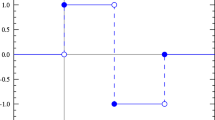Abstract
A new approach to determining the amplitude levels of piecewise constant signal has been proposed that is based on using its multiplicative model and solving the problem of polynomial approximation. In case of the absence of noise, the statement of polynomial approximation problem is based on the requirement of exact match of the current signal value with the amplitude value of one of its levels. In case of the presence of ordinary additive noise, the problem statement is based on the least squares criterion, while the solution of problem is presented in the analytical form. For the case of the presence of pulse-type noise, the problem statement is based on the minimum duration criterion, while the problem solution is achieved numerically by an appropriate functional minimization in unknown amplitudes of levels. The case of binary piecewise constant signal is considered in detail. The results of numerical simulation are presented for the cases, where the binary signal is distorted by ordinary additive noise with Gaussian distribution law and the pulse-type noise with the Cauchy distribution law.
Similar content being viewed by others
References
A. Parekh and I. W. Selesnick, “Convex fused lasso denoising with non-convex regularization and its use for pulse detection,” Proc. of IEEE Signal Processing in Medicine and Biology Symp., Philadelphia, PA (IEEE, 2015), pp. 1–6, DOI: 10.1109/SPMB.2015.7405474.
K. Zhang, Q. Liu, H. Song, X. Li, “A variational approach to simultaneous image segmentation and bias correction,” IEEE Trans. Cybernetics 45, No. 8, 1426 (2015), DOI: 10.1109/TCYB.2014.2352343.
M. A. Little and N. S. Jones, “Generalized methods and solvers for noise removal from piecewise constant signals. I. Background Theory,” Proc. R. Soc. A 467, 3088 (2011), DOI: 10.1098/rspa.2010.0671.
M. A. Little and N. S. Jones, “Generalized methods and solvers for noise removal from piecewise constant signals. II. New Methods,” Proc. R. Soc. A 467, 3115 (2011), DOI: 10.1098/rspa.2010.0674.
G. Ongie and M. Jacob, “Recovery of piecewise smooth images from few Fourier samples,” Proc. of Int. Conf. on Sampling Theory and Applications, SampTA 25–29 May 2015 (IEEE, 2015), pp. 543–547, DOI: 10.1109/SAMPTA.2015.7148950.
I. W. Selesnick and M. A. Figueiredo, “Signal restoration with overcomplete wavelet transforms: comparison of analysis and synthesis priors,” Proc. SPIE 7446 (Wavelets XIII), 74460D (2009), DOI: 10.1117/12.826663.
C. C. Aggarwal and C. K. Reddy, Data Clustering: Algorithms and Applications (Chapman and Hall/CRC, N.-Y., 2013).
S. M. Vovk and V. F. Borulko, “Minimum duration method for recovery of finite signals,” Radioelectron. Commun. Syst. 34, No. 8, 66 (1991).
V. F. Borulko and S. M. Vovk, “Minimum-duration filtering,” Radio Electronics, Computer Science, Control, No. 1, 7 (2016), DOI: 10.15588/1607-3274-2016-1-1.
J. G. Gonzalez and G. R. Arce, “Optimality of the myriad filter in practical impulsive-noise environments,” IEEE Trans. Signal Process. 49, No. 2, 438 (2001), DOI: 10.1109/78.902126.
T. C. Aysal and K. E. Barner, “Meridian filtering for robust signal processing,” IEEE Trans. Signal Process. 55, No. 8, 3949 (2007), DOI: 10.1109/TSP.2007.894383.
R. E. Carrillo, T. C. Aysal, and K. E. Barner, “Generalized Cauchy distribution based robust estimation,” Proc. of Int. Conf. on Acoustic, Speech and Signal Processing, ICASSP, 31 Mar.–4 Apr. 2008, Las Vegas (IEEE, 2008), pp. 3389–3392, DOI: 10.1109/ICASSP.2008.4518378.
S. M. Vovk and V. F. Borulko, “Statement of a problem of definition of linear signals parameters in quasinormed space,” Radioelectron. Commun. Syst. 53, No. 7, 367 (2010), http://radioelektronika.org/article/view/ S0735272710070046.
V. F. Borulko and S. M. Vovk, Principle of minimum extent in spatial spectrum extrapolation problems of complex-valued sources,” Telecom. Radio Eng. 72, No. 7, 581 (2013), DOI: 10.1615/TelecomRadEng.v72.i7.30.
S. M. Vovk and V. F. Borulko, “Dual method of minimum spatial extent for robust estimation of dipole radiation sources,” Radio Electronics, Computer Science, Control, No. 2, 8 (2014), DOI: 10.15588/1607-3274-2014-2-1.
Author information
Authors and Affiliations
Corresponding author
Additional information
Original Russian Text © S.M. Vovk, V.F. Borulko, 2017, published in Izvestiya Vysshikh Uchebnykh Zavedenii, Radioelektronika, 2017, Vol. 60, No. 3, pp. 141–153.
ORCID: 0000-0002-8116-3500
ORCID: 0000-0002-8895-1059
About this article
Cite this article
Vovk, S.M., Borulko, V.F. Determination of amplitude levels of the piecewise constant signal by using polynomial approximation. Radioelectron.Commun.Syst. 60, 113–122 (2017). https://doi.org/10.3103/S0735272717030037
Received:
Published:
Issue Date:
DOI: https://doi.org/10.3103/S0735272717030037




